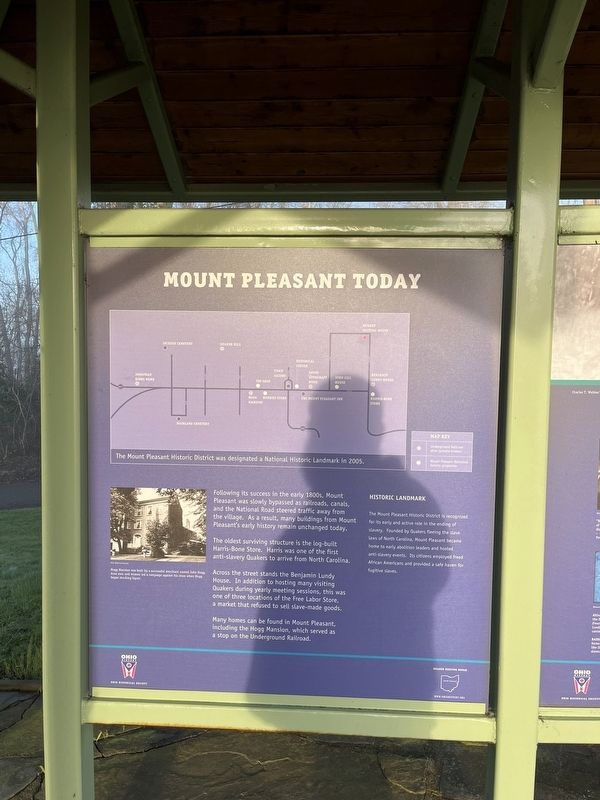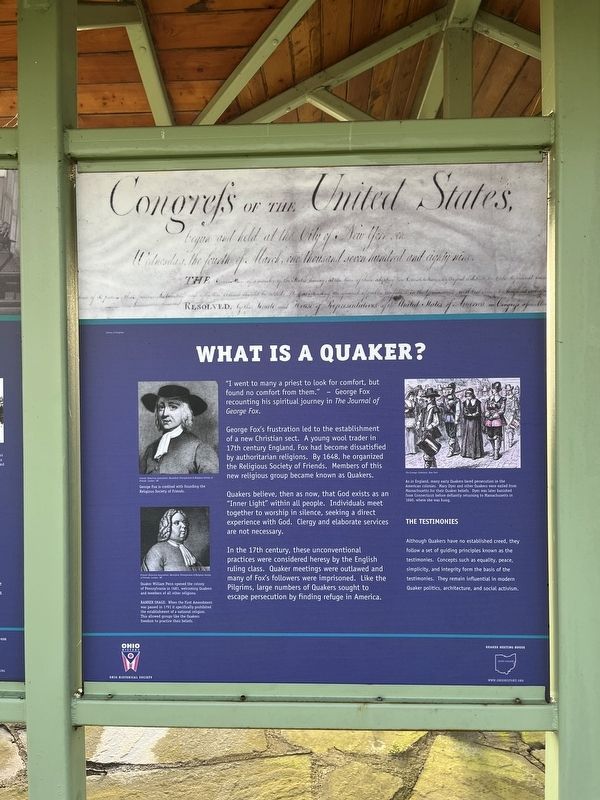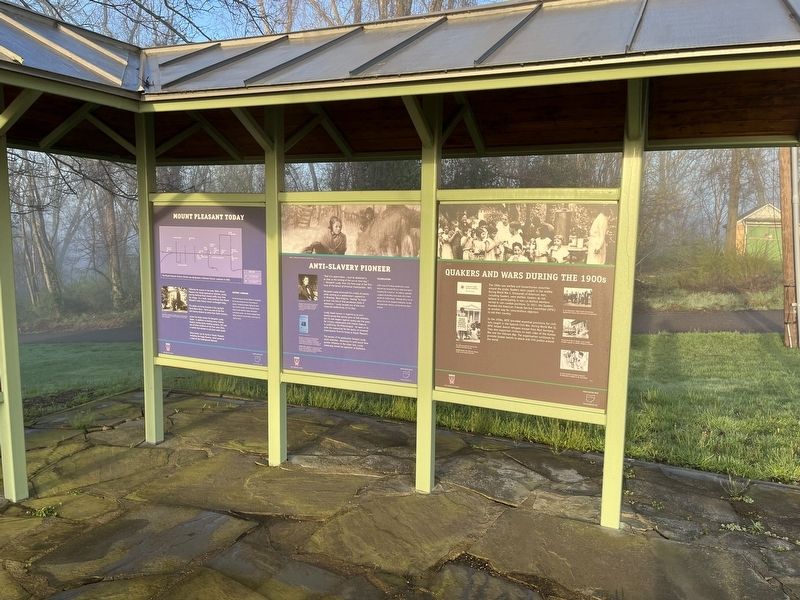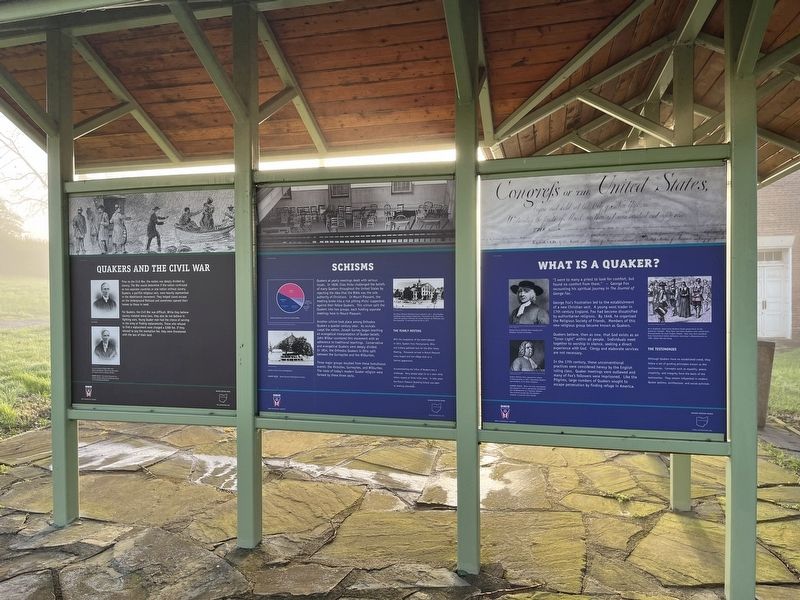Mount Pleasant in Jefferson County, Ohio — The American Midwest (Great Lakes)
Mount Pleasant Today / What Is A Quaker?
Mount Pleasant Today
Following its success in the early 1800s, Mount Pleasant was slowly bypassed as railroads, canals, and the National Road steered traffic away from the village. As a result, many buildings from Mount Pleasant’s early history remain unchanged today.
The oldest surviving structure is the log-built Harris-Bone Store. Harris was one of the first anti-slavery Quakers to arrive from North Carolina.
Across the street stands the Benjamin Lundy House. In addition to hosting many visiting Quakers during yearly meeting sessions, this was one of three locations of the Free Labor Store, a market that refused to sell slave-made goods.
Many homes can be found in Mount Pleasant, including the Hogg Mansion, which served as a stop on the Underground Railroad.
[Sidebar:]
Historic Landmark
The Mount Pleasant Historic District is recognized for its early and active role in the ending of slavery. Founded by Quakers fleeing the slave laws of North Carolina, Mount Pleasant became home to early abolition leaders and hosted anti-slavery events. Its citizens employed freed African Americans and provided a safe haven for fugitive slaves.
[Captions:]
The Mount Pleasant Historic District was designated a National Historic Landmark in 2005.
Hogg Mansion was built by a successful merchant named John Hogg. Area men and women led a campaign against his store when Hogg began stocking liquor.
What Is A Quaker?
"I went to many a priest to look for comfort, but found no comfort from them." — George Fox recounting his spiritual journey in The Journal of George Fox.
George Fox’s frustration led to the establishment of a new Christian sect. A young wool trader in 17th century England, Fox had become dissatisfied by authoritarian religions. By 1648, he organized the Religious Society of Friends. Members of this new religious group became known as Quakers.
Quakers believe, then as now, that God exists as an “Inner Light” within all people. Individuals meet together to worship in silence, seeking a direct experience with God. Clergy and elaborate services are not necessary.
In the 17th century, these unconventional practices were considered heresy by the English ruling class. Quaker meetings were outlawed and many of Fox’s followers were imprisoned. Like the Pilgrims, large numbers of Quakers sought to escape persecution by finding refuge in America.
[Sidebar:]
The Testimonies
Although Quakers have no established creed, they follow a set
[Captions:]
George Fox is credited with founding the Religious Society of Friends.
Quaker William Penn opened the colony of Pennsylvania in 1681, welcoming Quakers and members of all other religions.
Banner image: When the First Amendment was passed in 1791 it specifically prohibited the establishment of a national religion. This allowed groups like the Quakers freedom to practice their beliefs.
As in England, many early Quakers faced persecution in the American colonies. Mary Dyer and other Quakers were exiled from Massachusetts for their Quaker beliefs. Dyer was later banished from Connecticut before defiantly returning to Massachusetts in 1660, where she was hung.
Erected by Ohio Historical Society.
Topics and series. This historical marker is listed in this topic list: Settlements & Settlers. In addition, it is included in the National Historic Landmarks, the Ohio Historical Society / The Ohio History Connection, and the Quakerism series lists. A significant historical year for this entry is 2005.
Location.
Other nearby markers. At least 8 other markers are within walking distance of this marker. Building the Meetinghouse / Abolition (here, next to this marker); Anti-Slavery Pioneer / Schisms (here, next to this marker); Mount Pleasant's Beginnings / The Testimony of Equality (here, next to this marker); Quakers and Wars During the 1900s / Quakers and the Civil War (here, next to this marker); Samuel Gill House (about 500 feet away, measured in a direct line); Benjamin Lundy Home / Free Labor Store (about 500 feet away); Free Labor Store / Benjamin Lundy House (about 500 feet away); Elizabeth House Mansion (about 500 feet away). Touch for a list and map of all markers in Mount Pleasant.
Credits. This page was last revised on November 23, 2023. It was originally submitted on April 23, 2022, by Jamie Abel of Westerville, Ohio. This page has been viewed 150 times since then and 12 times this year. Photos: 1, 2, 3, 4. submitted on April 23, 2022, by Devry Becker Jones of Washington, District of Columbia. • Devry Becker Jones was the editor who published this page.



